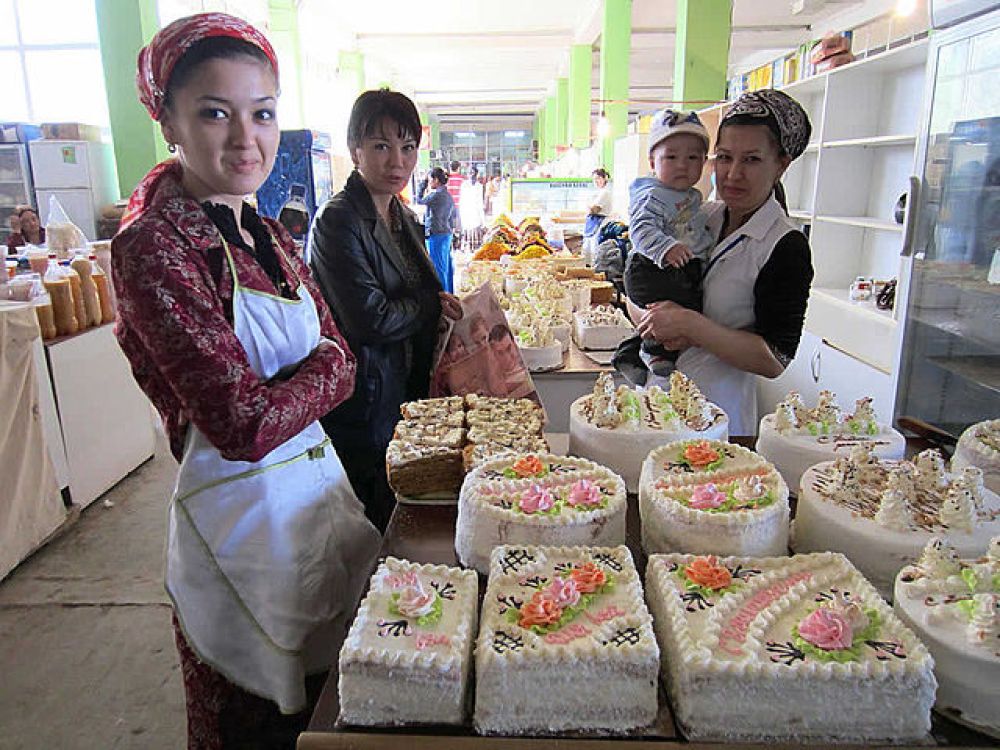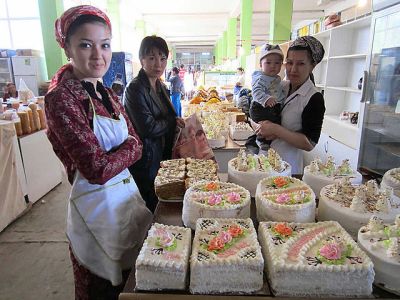

The Dashoguz Bazaar offers an authentic slice of life in Northern Turkmenistan. This vibrant market is the shopping hub of Dashoguz, providing a sensory overload with its rich smells, colorful sights, and cacophony of sounds. Visitors can browse a range of goods, from traditional Turkmen carpets, which are famous for their intricate designs and excellent craftsmanship, to locally produced clothes, and fresh produce including fruits, vegetables, and spices. While wandering through the bazaar, guests have the opportunity to engage with friendly local vendors, sample some regional delicacies, and observe the traditional way of bartering and trade. It's a perfect place to pick up souvenirs such as handmade crafts, jewelry, or traditional musical instruments. The market also gives insights into the daily lives of the Turkmen people, making it a culturally enriching experience.
At the Dashoguz Bazaar, one can delve into the world of Turkmen weaving and carpet-making, a tradition that is deeply embedded in the nation's culture and recognized by UNESCO as an intangible cultural heritage. Turkmen carpets, known for their distinctive patterns and red hues, tell stories through their designs. Visitors can witness the artistry of local weavers as they skillfully create these masterpieces, often using techniques that have been passed down for generations. Exploring the various styles and patterns available at the bazaar not only enhances one's understanding of Turkmen heritage but also provides a chance to purchase a piece of history. A visit here is an educational journey through the symbolism and craft of rug making, which plays a pivotal role in Turkmenistan social customs.
The culinary experience in Dashoguz Bazaar is an adventure of its own. Foodies can savor a plethora of Turkmen dishes that reflect the country's diverse culture and agricultural traditions. From tasting freshly baked flatbreads, known as chorek, to enjoying local sweets or indulging in plov, a rice dish beautifully cooked with carrots, onions, and meat, there is a variety of flavors to explore. Sampling the camel milk, which is a staple in Turkmen diets, could be particularly intriguing for the adventurous eaters. The bazaar's food stalls also serve shashlik, skewered and grilled meats that are a favorite throughout Central Asia. The experience is also about interaction; it is a chance to sit among locals, watch as they prepare meals using age-old methods, and perhaps learn a recipe or two from friendly stallholders.
Dashoguz Bazaar is a treasure trove for traditional Turkmen jewelry, which is famed for its unique designs and historical significance. These pieces often feature semi-precious stones, silver, and intricate patterns that are rich in cultural symbolism. The jewels are more than mere adornments; they serve as a form of artistic expression, reflecting both the personal style and the tribal identity of the wearer. Visitors can find a diverse range of items, from elegant silver bracelets and necklaces to elaborate headdresses called 'tahya,' worn by Turkmen women during special occasions. Purchasing jewelry at the bazaar not only makes for a lovely keepsake but also supports the local craftsmen who have honed their skills over many years. Guided by their expertise, you can choose an authentic and meaningful piece to remember your visit to Dashoguz.
For a more unconventional experience, the weekly animal market at the outskirts of Dashoguz Bazaar cannot be missed. The market comes to life early in the morning when local farmers bring in livestock for trade. It's a scene right out of the pages of history, with cattle, sheep, goats, and sometimes camels being bartered and sold amidst animated negotiation. Visitors get a glimpse of rural Turkmen life and can observe age-old trading customs firsthand. The cacophony of animal sounds, the sights of traditional rural fashion, and the general buzz of activity provide a truly immersive experience. One doesn’t need to be in the market for livestock to appreciate this cultural spectacle, which is as much a social gathering as it is a business venue.
For aspiring and professional photographers alike, the Dashoguz Bazaar offers a plethora of opportunities to capture the vibrant culture of Turkmenistan. The myriad of colorful stalls, the traditional dress of the local people, and the array of diverse goods provide countless subjects for a photography walk. The warm and welcoming nature of the Turkmen people often means that visitors will find willing portrait subjects among the stallholders and shoppers. Capturing the shimmering hues of the carpets, the detailed work of jewelry, or the dynamic scenes of the animal market can result in some breathtaking photographs. It’s not just an opportunity to refine one's photography skills but also a means to document the heart and soul of Turkmenistan through its bustling bazaar life.
Dashoguz is not just renowned for its carpets, but also for its silk and textiles. The bazaar’s textile section is a colorful display of the fabrics that are used in traditional Turkmen clothing, such as dresses and headscarves. Silk, in particular, can be found in various forms, from raw unprocessed threads to beautifully woven cloths. Shoppers may find lightweight cotton materials perfect for the scorching Turkmen summers. Fabric shopping in the bazaar is also an interactive experience; visitors can learn about natural dyes used in coloring the materials and the significance of different patterns. These textiles serve as the ideal material for fashion enthusiasts wanting to create their own Turkmen-inspired garments or for anyone looking to take home a piece of Turkmen art and culture.
A visit to the spice section of Dashoguz Bazaar is an assault on the senses in the best possible way. The array of spices available, from vibrant turmeric to fragrant cumin, is a testament to the culinary richness of Turkmen cuisine. These spices add depth and flavor to Turkmen dishes and are available in their freshest form in the bazaar. Alongside spices, numerous stalls offer dried fruits and nuts, staples in local snacking and cooking. Visitors can taste sun-dried apricots, figs, dates, and raisins, or various nuts like almonds and pistachios. These treats are not only delicious but also provide an understanding of the food preservation methods necessary in Turkmenistan’s desert climate. They also make great gifts or travel snacks, packed with energy for further exploration.
The Dashoguz Bazaar is more than just a place to shop; it's a living center of cultural interaction. Travelers who are interested in learning about the Turkmen way of life can engage with locals in friendly conversation and even partake in an informal language exchange. The Turkmen are known for their hospitality and often enjoy the chance to share stories about their traditions, family, and work. Visitors can pick up simple Turkmen phrases, try their hand at conversational Russian (commonly spoken in urban areas of Turkmenistan), or simply communicate through the universal language of smiles and gestures. This exchange not only enhances the visitor's cultural appreciation but builds bridges between different worlds, one conversation at a time.
Occasionally, Dashoguz Bazaar becomes a stage for local musicians and dancers to showcase their art. Traditional Turkmen music, featuring instruments like the dutar (a two-stringed lute) and the tambur (a long-necked bowed instrument), fills the air and adds to the quintessential Central Asian atmosphere. Performers in colorful, ornate costumes dance to these tunes, illustrating stories and traditions through their movements. These performances provide a rare opportunity for visitors to witness and even participate in traditional Turkmen dance, offering a deeper connection to the local culture. Engaging with the musicians and dancers can also be an enlightening experience, as they are often guardians of musical heritage, keeping ancient melodies and dance forms alive in modern Turkmen society.
